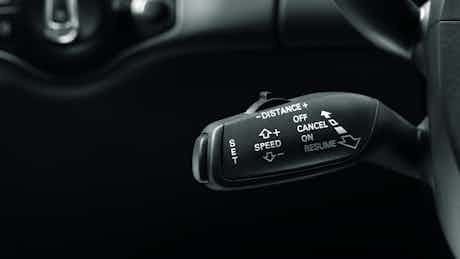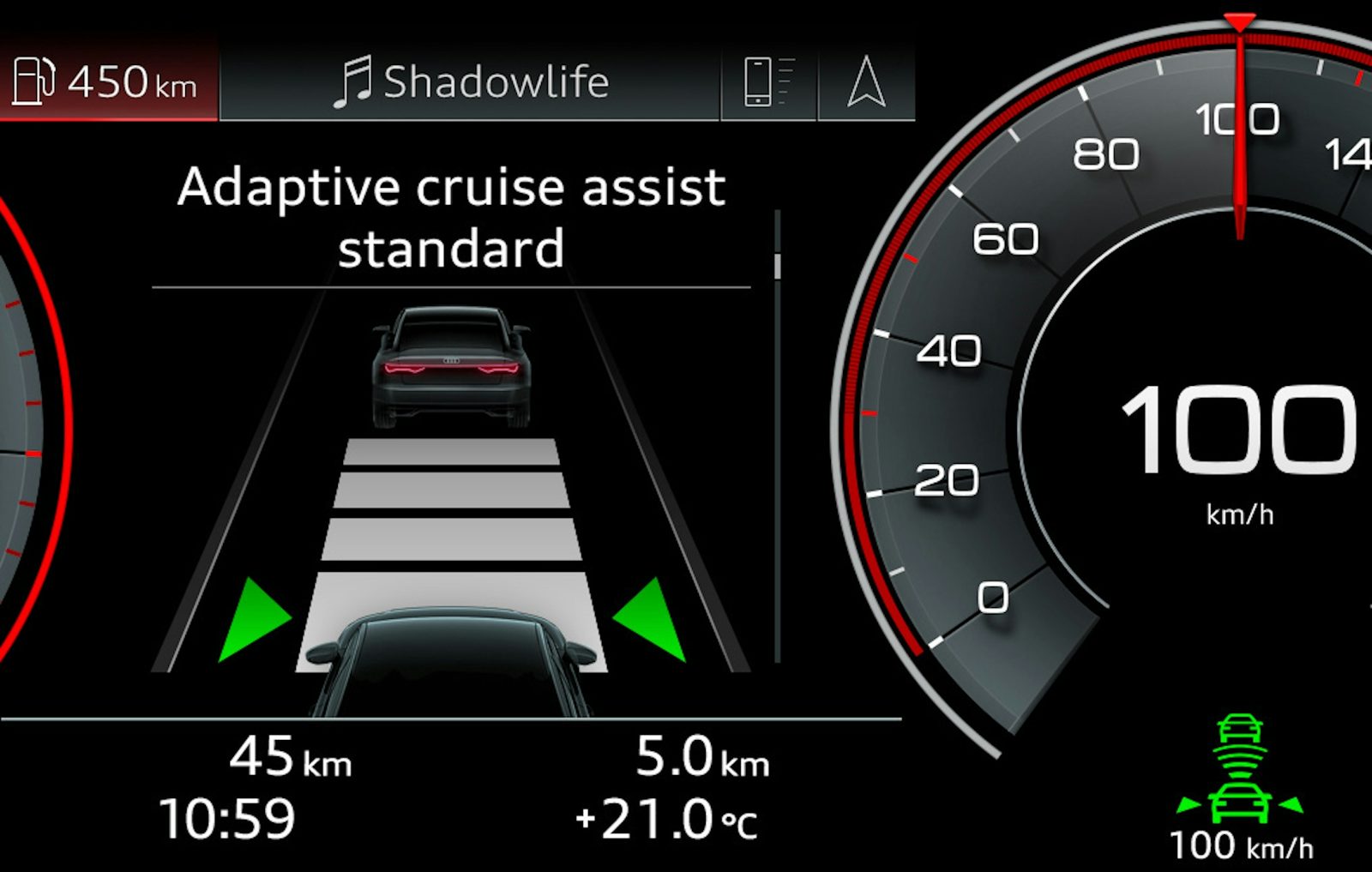What is cruise control and how to use it
June 23, 2025 by Neil Briscoe

Cruise control is a standard feature of many cars, and systems can be standard or ‘adaptive’. Learn more about cruise control and how to use it.
Cruise control is a handy tool, even a driver aid, which can help you keep your car at a constant speed when cruising on main roads and motorways. This guide will tell you how to use cruise control, and answer the question: how does cruise control work?
What is cruise control?
Cruise control is an electronic system which, when activated, holds your car to a pre-set speed. You can adjust the speed at which you want to cruise using a column stalk or buttons on the steering wheel, depending on the model of your car, and it’s a handy way to maintain a steady speed on long journeys, and avoid accidentally exceeding the speed limit.
What is adaptive cruise control?
Adaptive cruise control is cruise control but with the addition of a forward-facing radar and cameras, which are linked to the car’s accelerator and brakes. Now, when you choose a set speed, if you come up behind a slower car, the radar and camera will detect that car, and slow you down to match its speed, holding you at a safe distance behind. If the car in front slows down, you slow down. If it speeds up, you speed up, at least up to your pre-set speed. If you pull out to overtake, adaptive cruise control will accelerate for you, again up to your pre-set speed.
Many people think that adaptive cruise is some form of autonomous driving, but it’s not – it’s simply a safer way to keep your car at a constant speed, and it most definitely needs you to be awake and alert at the wheel. Carwow has tested some of the most advanced adaptive cruise control systems available.
How does cruise control work?
The earliest form of modern cruise control – as developed for Chrysler in 1948, by blind inventor Ralph Teetor, and marketed as ‘Speed-O-Stat’ – used a combination of a vacuum pump to control the throttle and a physical governor which prevented the accelerator pedal from being pushed any further.

Modern cruise control is a bit more sophisticated, and uses electronic controls to set a desired speed, automatically compensating for hills and downslopes. It’s designed to keep your car at a pre-set speed on motorways and major roads, and isn’t really suitable for use on tighter and twistier roads, or in town (unless you have adaptive cruise control with a stop-start traffic mode).
Remember, you can buy a brand new or used car right here on Carwow. And you can sell your car, too. We’re here to help you through every step of your car-changing journey.
How to use cruise control
How the cruise control works in your car will vary slightly between made and model, but generally speaking will involve using either a dedicated column stalk behind the steering wheel, or buttons on the steering wheel.
Cruise control functions are pretty simple: you have an on and off switch, a ‘+’ and ‘-‘ button for increasing or decreasing your set speed, a cancel button, and a resume button.
To use cruise control, once you’ve reached your desired speed, simply turn it on and press the ‘+’ or ‘-‘ button to set the speed (some systems will also include a specific ‘set’ button. Once set, you can use the ‘+’ and ‘-‘ buttons to increase or decrease your speed. In most cars, a short press on either will raise or lower your speed by 1mph, while a long held press will increase or decrease your speed in either 5mph or 10mph increments.

Cruise control is best used on a large, mostly quiet multi-lane road such as a motorway or a major A-road. Remember that unless you have adaptive cruise control (see above) your car will maintain its set speed even if you come up behind a slower vehicle.
Cruise control has a fail-safe, which is that as soon as you tap your brakes, it will automatically switch off. Once you’ve finished braking, and if the road ahead is clear, you can switch it all back on again by using the ‘resume’ button, which saves your last set speed in its memory. You can, of course, also cancel your cruising speed by using the ‘cancel’ or ‘on/off’ buttons.
In most cars, you can also override the cruise control system by accelerating using the throttle pedal, which will allow you to speed up, and then you will return to your set cruising speed as you slow down, unless you’ve braked or cancelled the cruise control.
When to use cruise control
Cruise control is best used on major roads and motorways, and unless you have adaptive cruise control (see above) it’s best deployed when the road is relatively quiet and you don’t have to slow down too often for other traffic. Cruise control is most useful on a longer journey, as it takes the task of concentrating on maintaining a constant speed and keeping under the speed limit away from the driver.
When not to use cruise control
You shouldn’t use cruise control when travelling at a constant speed isn’t a good idea. For example, when in heavy traffic when the speed is constantly changing, when on a twisty, windy road, or in town, or when approaching a blind brow or steep bridge.
It’s also a bad idea to use cruise control in very heavy rain or when there’s ice on the road. In theory, in a modern car, as soon as any loss of traction is detected, the cruise control will automatically switch off, but it can still potentially increase the risk of a skid or a slide. Equally, on long journeys late at night, cruise control may not be a good idea, as it might reduce the amount of attention you’re paying to driving, and can potentially increase the chance of you falling asleep.
Pros and cons of cruise control
Pros of cruise control
- Helps you maintain a set speed.
- Means you don’t have to worry about speed limits as much.
- Takes some of the workload off the driver.
- Can potentially help you save fuel on a long journey.
Cons of cruise control
- Won’t slow down for other traffic (unless you have adaptive cruise control).
- Easy to become reliant on it and pay less attention to your driving.
- Can increase the chance of skidding or sliding on a slippery road.
Cruise control FAQs
Does cruise control save fuel?
It can do. In theory, an attentive driver can actually be more economical than just running along at a set speed with cruise control, but for most of us cruise control will actually help you save some fuel, as a constant speed is easier on the engine.
Is it good or bad to use cruise control?
It depends on the circumstances. As with any driver aid, cruise control is a tool to be used at the right time, in the right place, and with the driver still in control and paying attention.
Can you brake on cruise control?
Yes – in any cruise control system, as soon as you touch the brake pedal, the cruise control should automatically switch off.
Where should I use cruise control?
Cruise control is best used on motorways and major multi-lane roads, and when traffic is relatively light and you can see plenty of clear roads in front of you.
Does cruise control drain the battery?
It certainly can do. Long motorway journeys are the worst thing for any electric car’s range, as you’re not braking as often to top up the battery through regenerative braking. Activating cruise control can potentially make that worse, as it will keep the power on when going up long uphill stretches and again on the way back down – driving ‘manually’, controlling your speed yourself, can be a more efficient way of driving an EV.
Car change? Carwow!
Looking for a new set of wheels? With Carwow you can sell your car quickly and for a fair price – as well as find great offers on your next one. Whether you’re looking to buy a car brand new, are after something used or you want to explore car leasing options, Carwow is your one stop shop for new car deals.
Click here to follow us on WhatsApp, where you can keep up-to-date with all the latest news, reviews, advice guides and videos.















